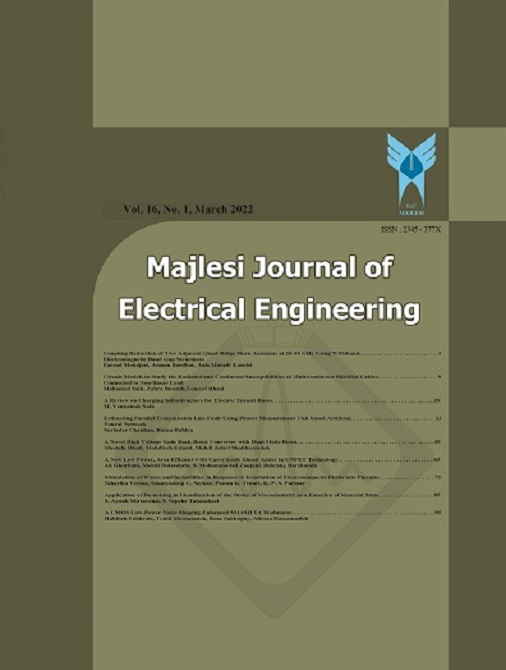Document Type : Reseach Article
Authors
1 Department of Electrical and Electronics, Manipal Institute of Technology, Manipal Academy of Higher Education, Manipal, Karnataka, India.
2 Department of Electrical Engineering, Kolhapur Institute of Technology’s College of Engineering (Autonomous), Kolhapur, Maharashtra, India.
3 Department of Mechatronics, Manipal Institute of Technology, Manipal Academy of Higher Education, Manipal, Karnataka, India.
Abstract
The steadily increasing acceptance of battery technology has created numerous opportunities for identifying new technologies and methods to improve the performance and safety of batteries used in various applications, including electric vehicles and digital devices. The current study focuses on the interaction of hardware and software for recording and monitoring battery pack data. The battery management system uses IoT technology, a microcontroller, and sensors to collect voltage and temperature data from battery cells. The individual cell voltage reached approximately 4.2 volts and achieved a full charge of 99%, which was measured locally and displayed remotely on a mobile dashboard via an IoT server. The cells are charged in parallel, and the entire charging process for all cells is completed in about 10 minutes. The battery pack temperature was continuously monitored during charging and discharging, assisting in mitigating risks and improving battery lifespan through proper data. The battery management system’s ability to monitor charging and discharging cycles and their performance allows for corrective actions and informed decision-making to ensure safe operation. Validation, testing, and demonstration of the effectiveness of the IoT-based hybrid-powered battery management system revealed its ability to detect battery performance issues and exchange data for disciplinary action. This creates a safe environment for the use of battery management systems in a variety of battery operations.
Keywords
- Pourrahmani, H., Yavarinasab, A., Zahedi, R., Gharehghani, A., Mohammadi, M. H., & Bastani, P. (2022). The applications of Internet of Things in the automotive industry: A review of the batteries, fuel cells, and engines. Internet of Things, 19, 100579. https://doi.org/10.1016/j.iot.2022.100579
- Rahim, M. A., Rahman, M. A., Rahman, M. M., Asyhari, A. T., Bhuiyan, M. Z. A., & Ramasamy, D. (2021). Evolution of IoT-enabled connectivity and applications in the automotive industry: A review. Vehicular Communications, 27, 100285. https://doi.org/10.1016/j.vehcom.2020.100285
- Lebrouhi, B. E., Khattari, Y., Lamrani, B., Maaroufi, M., Zeraouli, Y., & Kousksou, T. (2021). Key challenges for a large-scale development of battery electric vehicles: A comprehensive review. Journal of Energy Storage, 44, 103273. https://doi.org/10.1016/j.est.2021.103273
- Christensen, P. A., Anderson, P. A., Harper, G. D., Lambert, S. M., Mrozik, W., Rajaeifar, M. A., ... & Heidrich, O. (2021). Risk management over the life cycle of lithium-ion batteries in electric vehicles. Renewable and Sustainable Energy Reviews, 148, 111240. https://doi.org/10.1016/j.rser.2021.111240
- Kurucan, M., Özbaltan, M., Yetgin, Z., & Alkaya, A. (2024). Applications of artificial neural network-based battery management systems: A literature review. Renewable and Sustainable Energy Reviews, 192, 114262. https://doi.org/10.1016/j.rser.2023.114262
- Lin, X., Kim, Y., Mohan, S., Siegel, J. B., & Stefanopoulou, A. G. (2019). Modeling and estimation for advanced battery management. Annual Review of Control, Robotics, and Autonomous Systems, 2(1), 393-426. https://doi.org/10.1146/annurev-control-053018-023643
- Gong, X., Xiong, R., & Mi, C. C. (2014). Study of the characteristics of battery packs in electric vehicles with parallel-connected lithium-ion battery cells. IEEE Transactions on Industry Applications, 51(2), 1872-1879. DOI: 1109/TIA.2014.2345951
- Hou, J., Yang, M., Wang, D., & Zhang, J. (2020). Fundamentals and challenges of lithium-ion batteries at temperatures between− 40 and 60° C. Advanced Energy Materials, 10(18), 1904152. https://doi.org/10.1002/aenm.201904152
- Duan, J., Tang, X., Dai, H., Yang, Y., Wu, W., Wei, X., & Huang, Y. (2020). Building safe lithium-ion batteries for electric vehicles: a review. Electrochemical Energy Reviews, 3, 1-42. DOI: 1007/s41918-019-00060-4
- Omariba, Z. B., Zhang, L., & Sun, D. (2019). Review of battery cell balancing methodologies for optimizing battery pack performance in electric vehicles. IEEE Access, 7, 129335-129352. DOI: 1109/ACCESS.2019.2940090
- Gonzalez, I., Calderón, A. J., & Folgado, F. J. (2022). IoT real time system for monitoring lithium-ion battery long-term operation in microgrids. Journal of Energy Storage, 51, 104596. https://doi.org/10.1016/j.est.2022.104596
- Datta, U., Kalam, A., & Shi, J. (2021). A review of key functionalities of battery energy storage system in renewable energy integrated power systems. Energy Storage, 3(5), e224. https://doi.org/10.1002/est2.224
- Sutikno, T., Arsadiando, W., Wangsupphaphol, A., Yudhana, A., & Facta, M. (2022). A review of recent advances in hybrid energy storage system for solar photovoltaics power generation. Ieee Access, 10, 42346-42364. https://doi.org/10.1109/access.2022.3165798
- Rathor, S. K., & Saxena, D. (2020). Energy management system for smart grid: An overview and key issues. International Journal of Energy Research, 44(6), 4067-4109. https://doi.org/10.1002/er.4883
- Arfeen, Z. A., Kermadi, M., Azam, M. K., Siddiqui, T. A., Akhtar, Z. U., Ado, M., & Abdullah, M. P. (2020). Insights and trends of optimal voltage‐frequency control DG‐based inverter for autonomous microgrid: State‐of‐the‐art review. International Transactions on Electrical Energy Systems, 30(10), e12555. https://doi.org/10.1002/2050-7038.12555
- Zafar, U., Bayhan, S., & Sanfilippo, A. (2020). Home energy management system concepts, configurations, and technologies for the smart grid. IEEE access, 8, 119271-119286. DOI: 1109/ACCESS.2020.3005244
- Sadeeq, M. A., & Zeebaree, S. (2021). Energy management for internet of things via distributed systems. Journal of Applied Science and Technology Trends, 2(02), 80-92. DOI: 38094/jastt20285
- Xing, L. (2020). Reliability in Internet of Things: Current status and future perspectives. IEEE Internet of Things Journal, 7(8), 6704-6721. DOI: 1109/JIOT.2020.2993216
- Sharma, N., Shamkuwar, M., & Singh, I. (2019). The history, present and future with IoT. Internet of things and big data analytics for smart generation, 27-51. DOI: 1007/978-3-030-04203-5_3
- Asaad, M., Ahmad, F., Alam, M. S., & Rafat, Y. (2018). IoT-enabled monitoring of an optimized electric vehicle’s battery system. Mobile Networks and Applications, 23, 994-1005.
https://doi.org/10.1007/s11036-017-0957-z - Rana, B., Singh, Y., & Singh, P. K. (2021). A systematic survey on internet of things: Energy efficiency and interoperability perspective. Transactions on Emerging Telecommunications Technologies, 32(8), e4166. https://doi.org/10.1002/ett.4166

